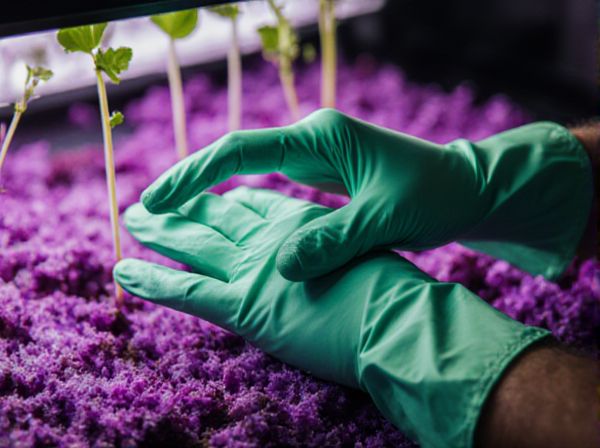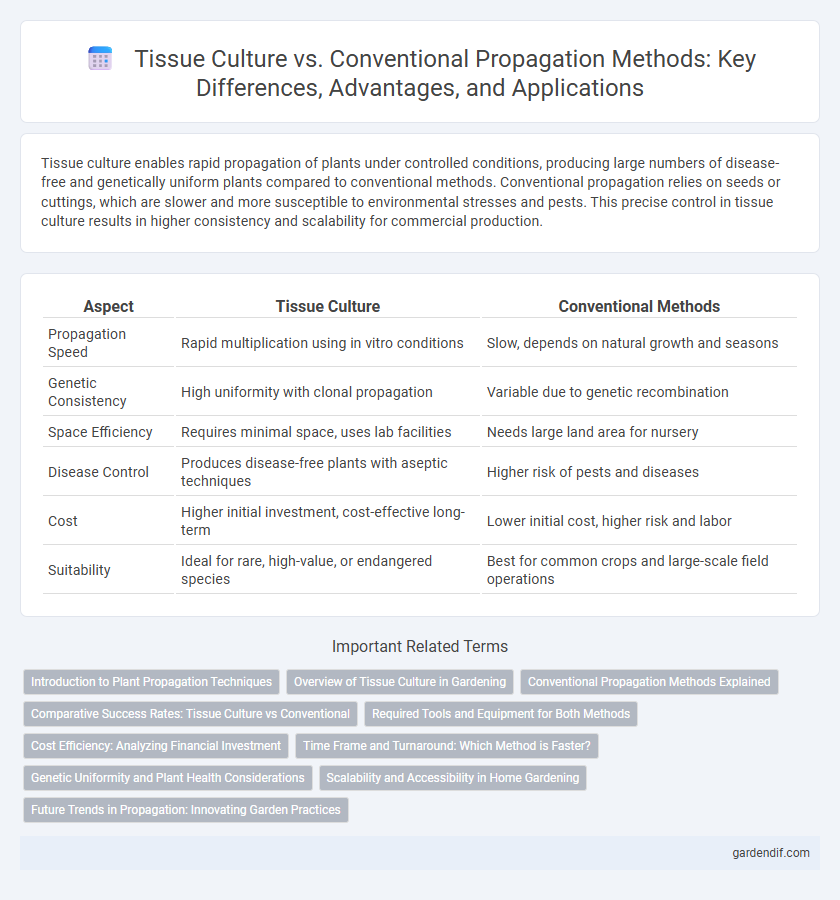
Tissue Culture vs Conventional Methods Illustration
Tissue culture enables rapid propagation of plants under controlled conditions, producing large numbers of disease-free and genetically uniform plants compared to conventional methods. Conventional propagation relies on seeds or cuttings, which are slower and more susceptible to environmental stresses and pests. This precise control in tissue culture results in higher consistency and scalability for commercial production.
Table of Comparison
| Aspect | Tissue Culture | Conventional Methods |
|---|---|---|
| Propagation Speed | Rapid multiplication using in vitro conditions | Slow, depends on natural growth and seasons |
| Genetic Consistency | High uniformity with clonal propagation | Variable due to genetic recombination |
| Space Efficiency | Requires minimal space, uses lab facilities | Needs large land area for nursery |
| Disease Control | Produces disease-free plants with aseptic techniques | Higher risk of pests and diseases |
| Cost | Higher initial investment, cost-effective long-term | Lower initial cost, higher risk and labor |
| Suitability | Ideal for rare, high-value, or endangered species | Best for common crops and large-scale field operations |
Introduction to Plant Propagation Techniques
Plant propagation techniques include tissue culture and conventional methods, each offering unique advantages in crop multiplication. Tissue culture utilizes sterile, controlled environments to produce large numbers of genetically uniform plants rapidly, reducing disease transmission. Conventional methods rely on seeds, cuttings, layering, or grafting, benefiting from simplicity, cost-effectiveness, and adaptability to various crops and environments.
Overview of Tissue Culture in Gardening
Tissue culture in gardening enables rapid propagation of plants through controlled, sterile environments, producing disease-free and genetically uniform seedlings. This method allows for mass production of rare or high-demand plant varieties with consistent quality compared to conventional methods. Tissue culture also optimizes space and resource use, significantly accelerating growth cycles and improving overall plant health.
Conventional Propagation Methods Explained
Conventional propagation methods involve techniques such as seed sowing, cuttings, grafting, and layering, which rely on natural plant reproduction processes to produce offspring with genetic variation. These traditional methods are widely used due to their simplicity, cost-effectiveness, and suitability for a broad range of crops, although they often require longer timeframes for plant establishment compared to tissue culture. Factors affecting success include environmental conditions, parent material quality, and operator skill, making conventional propagation less predictable but still essential for sustainable agriculture.
Comparative Success Rates: Tissue Culture vs Conventional
Tissue culture propagation exhibits significantly higher success rates, often exceeding 90%, due to its sterile environment and controlled conditions that minimize contamination and promote uniform growth. Conventional propagation methods, such as cuttings or seed sowing, typically show success rates ranging from 40% to 70%, heavily influenced by environmental factors and genetic variability. The precision and scalability of tissue culture make it a superior choice for achieving consistent and rapid plant multiplication compared to conventional approaches.
Required Tools and Equipment for Both Methods
Tissue culture requires sterile laminar flow cabinets, autoclaves, growth media, and controlled environment chambers to ensure contamination-free propagation and optimal growth conditions. Conventional methods primarily rely on basic tools like pruning shears, rooting hormones, soil or substrate, and greenhouses or shade nets for manual plant propagation. The advanced equipment in tissue culture supports precision and scalability, whereas conventional propagation depends on more accessible and traditional tools.
Cost Efficiency: Analyzing Financial Investment
Tissue culture requires higher initial financial investment due to specialized equipment and controlled laboratory conditions, but it offers cost efficiency through rapid mass propagation and uniform plant quality. Conventional methods involve lower upfront costs but can incur higher long-term expenses because of slower growth rates and increased susceptibility to pests and diseases. Overall, tissue culture demonstrates superior cost efficiency by minimizing crop losses and accelerating propagation cycles.
Time Frame and Turnaround: Which Method is Faster?
Tissue culture enables rapid propagation by producing thousands of uniform plants in a shorter time frame, often within weeks, compared to conventional methods that may take months due to slower seed germination and vegetative growth. The controlled environment of tissue culture accelerates growth cycles and reduces variability, resulting in faster turnaround and higher consistency in plant quality. Conventional propagation relies on natural growth rates and environmental conditions, making it significantly slower and less predictable.
Genetic Uniformity and Plant Health Considerations
Tissue culture propagation ensures higher genetic uniformity by producing clones from a single parent plant, minimizing genetic variation commonly seen in conventional methods such as seed propagation. This method significantly reduces the risk of pathogen transmission, promoting improved plant health compared to traditional propagation techniques that can introduce soil-borne diseases. The sterile, controlled environment of tissue culture supports the rapid multiplication of disease-free plants, enhancing overall crop quality and consistency.
Scalability and Accessibility in Home Gardening
Tissue culture enables rapid, large-scale propagation of disease-free plants, making it highly scalable compared to conventional seed or cutting methods. This technique provides consistent quality and uniformity, which is crucial for gardeners seeking reliable plant growth in limited spaces. Conventional methods remain more accessible to home gardeners due to lower costs and simpler techniques, despite their slower propagation rates and variability in plant characteristics.
Future Trends in Propagation: Innovating Garden Practices
Advancements in tissue culture are revolutionizing plant propagation by enabling rapid multiplication of disease-free, genetically uniform plants compared to conventional methods, which rely on slower, less precise techniques like seed sowing or cuttings. Emerging technologies such as automated micropropagation systems and gene editing tools promise to enhance propagation efficiency, crop resilience, and biodiversity conservation. Integrating these innovative approaches into garden practices will drive sustainable cultivation, reduce resource use, and accelerate breeding programs for future horticultural development.
Tissue Culture vs Conventional Methods Infographic

 gardendif.com
gardendif.com